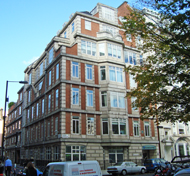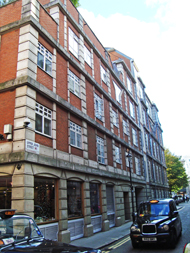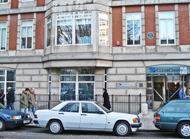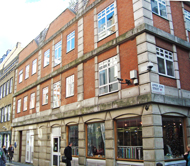Nose & Ear Hospital
Specialist
Successful clinical examination of the throat was impossible until the development of the laryngoscope in 1855, when a singer and music teacher in Paris, Manuel Garcia (1805-1906), reputedly invented a device from a dental mirror which could be inserted into the throat, with sunlight reflected from another mirror.
In 1862 Dr. Morell Mackenzie (1837-1892), one of the pioneers of laryngology, founded the Free Dispensary for Diseases of the Throat and Loss of Voice at 5 King Street (later renamed Kingly Street), off Regent Street. The Dispensary was an instant success and by 1865 it had moved to larger premises - 32 Golden Square - at the corner of Golden Square and Upper John Street. The building had previously housed the London Homoeopathic Hospital from 1851 to 1856. The Dispensary was renamed the Hospital for Diseases of the Throat - the first specialist throat hospital in the country - and the first in-patients were admitted.
Although originally free treatment had been provided, the Hospital became the first to adopt a provident system of payment, with patients contributing financially according to their means.
In 1865 Dr. Mackenzie wrote his first textbook on the subject - The Use of the Laryngoscope in Diseases of the Throat.
In 1872 the Prince of Wales became patron of the Hospital but, in the following year, the Hospital failed in its attempt to gain a Royal Charter and in its application for incorporation to the Board of Trade. Three Trustees were appointed to manage the financial affairs of the Hospital, but the situation continued to deteriorate. Members of the medical staff began to leave. Two of them - Drs. Lennox Browne and Llewellyn Thomas - left in 1874 to establish their own hospital, the Central London Throat and Ear Hospital in Grays Inn Road.
In 1877 the name of the Hospital was changed to the Hospital for Diseases of the Throat and Chest, at the instigation of Dr. William McNeill Whistler (who would establish the London Throat Hospital a decade later). This was because of the large number of patients attending with both laryngeal and pulmonary tuberculosis. The Hospital established outposts at 3, St John's Gardens in Notting Hill (the residents objected and it closed the following year) and at 7, Newington Butts in Walworth, near the Elephant and Castle, so that patients did not have to walk long distances to the main Hospital (the Walworth clinic closed in 1887 because of costs).
During the same year the Chairman of the Management Committee, the Matron and the Secretary, together with three porters, resigned following the death of Fanny Brookes, a patient who had undergone tracheotomy. The incident further damaged the reputation of the Hospital and four charges of maladministration were laid against Dr. Mackenzie.
In 1878 an inquiry was held into the financial management of the Hospital, resulting in withdrawal of royal patronage. In the same year an Ear Department was established, for the treatment of deafness.
Initially consisting of two houses, the Hospital had had 16 beds but the premises had been progressively enlarged by the purchase of adjoining properties as they became available. In 1883 the Hospital was altered to provide 21 adult beds and a children's ward.
In 1888, despite the events a decade earlier, Dr. Mackenzie was knighted by Queen Victoria for services to medicine and to the Emperor Frederick III. A known asthmatic, Dr. Mackenzie died of pneumonia, aged 54 years.
During 1897 and 1898 the Hospital building was demolished and rebuilt.
By the beginning of the 20th century, the distinct specialties of ear, nose and throat began to merge into one - otorhinolaryngology - more commonly known as ENT (ear, nose and throat).
In 1904 the Kings Fund proposed a merger of the five ENT hospitals in London - the Hospital for Diseases of the Throat, the Central London Throat and Ear Hospital, the Royal Ear Hospital, the London Throat Hospital and the Metropolitan Ear Nose & Throat Hospital. All resisted this, so funding was withheld from the hospitals in order to encourage reconsideration of the proposal.
The cost of an in-patient in 1913 was £2 1s 6d (£2.8) a week.
In 1914, at the beginning of the WW1, the Hospital appointed its first female House Surgeon, as five male members of staff had enlisted in the Army.
During the war the Hospital was affiliated to the Third London General Hospital, with 30 of its beds reserved for sick and wounded servicemen.
In 1918 the Hospital merged with the London Throat Hospital (the Royal Ear Hospital merged with University College Hospital the following year).
The Hospital was extended in 1925, when No. 33 was demolished to allow for the erection of a new building.
By 1939 the Hospital had 103 beds. In 1940 it legally merged with the Central London Throat and Ear Hospital in Grays Inn Road, the merger having been delayed by the outbreak of WW2. A joint Committee of Management was formed, but both Hospitals functioned independently during the war. The Golden Square premises were slightly damaged by bombing in 1940, but the new Royal National Throat Nose and Ear Hospital came into being on 1st January 1942, the largest ENT hospital in London with 225 beds.
It had been planned to build a new hospital after the war on the Grays Inn Road site, but the project was postponed and the Golden Square premises reconditioned in 1949.
By 1966 the Hospital at the Golden Square site had 96 beds.
In 1985 Bloomsbury Health Authority decided to close the Golden Square premises and to consolidate services at the Grays Inn Road branch.
Present status (October 2008)
The building is now the offices of the Clear Channel media group. A commemorative blue plaque dedicated to Sir Morell Mackenzie, founder of the first throat hospital in the world, can seen above the main entrance.

The building on the corner of Golden Square and Upper John Street.

The facade of the building in Upper John Street.

The main entrance in Golden Square. The blue plaque can be seen between the two windows on the right, above the entrance.

The commemorative plaque

The Beak Street facade, at the corner of Beak Street and Upper John Street.
(Author unstated) 1913 Reflections from a Board Room Mirror. British Journal of Nursing, 15th February, 134.
(Author unstated) 1913 Reflections from a Board Room Mirror. British Journal of Nursing, 20th September, 235.
(Author unstated) 1917 List of the various hospitals treating military cases in the United Kingdom. London, H.M.S.O.
Black N 2006 Walking London's Medical History. London, Royal Society of Medicine Press.
Cohen B 2003 The Royal National Throat Nose and Ear Hospital in World War II: a reminisence. Journal of Laryngology & Otology 117, 340-343.
Colledge L 1942 Amalgamation between the Golden Square Throat and Ear Hospital and the Central London Throat and Ear Hospital in Gray's Inn Road. Journal of Laryngology & Otology 57, 113-119.
Gould G 1998 A history of the Royal National Throat Nose and Ear Hospital 1874-1982. Journal of Laryngology & Otology 112, Suppl. 22.
Kershaw R 1913 British Ear and Throat Clinics historically considered. Journal of Laryngology, Rhinology, and Otology 28, 421-427.
Ormerod FC 1962 The centenary of the Golden Square Hospital and the 75th anniversary of the founding of the journal. Journal of Laryngology & Otology 76, 357-358.
Stevenson RS, Guthrie D 1949 The Development of Laryngology. In: A History of Oto-Laryngology. Edinburgh, E & S Livingstone, 103-107.
http://discovery.nationalarchives.gov.uk
http://rcnarchive.rcn.org.uk
https://aim25.ac.uk
https://historic-hospitals.com
www.british-history.ac.uk
www.innominatesociety.com
Return to home page